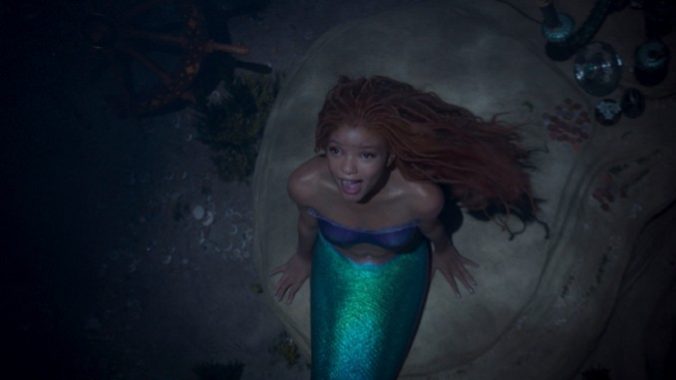Walt Disney’s Century: The Little Mermaid (2023)
Even the company’s dreams have now become more toil

This year, The Walt Disney Company turns 100 years old. For good or ill, no other company has been more influential in the history of film. Walt Disney’s Century is a monthly feature in which Ken Lowe revisits the landmark entries in Disney’s filmography to reflect on what they meant for the Mouse House—and how they changed cinema. You can read all the entries here.
Art exists despite the miserable toil that is the price of our subsistence—in defiance of the grueling winter, the empty bank account, the sanctimonious scolds among us. There is no day-to-day reason the cave dwellers at the dawn of humanity needed to paint representations of themselves hunting herd animals. There is no immediate material benefit, and often an associated punishment, to a kid in algebra class scribbling stick figures in the margins of his textbook so that when you flip the pages, the stick figures look like they’re doing kung fu on each other. Shut up and hunt the mammoth, cut the firewood, learn what an asymptote is, you lazy ingrate! Stop dreaming and produce. Your landlord is hungry.
But they do want art, the taskmasters and busybodies. Patronage of the arts—paying our dreamers so they don’t starve or get yelled at too much while they’re dreaming—has always been a trade-off for the dreamers: You can’t say anything bad about the Medicis if they’re paying you. Where that trade-off ceases to be worth it is something paid artists ask themselves every day.
Disney’s 2023 “live-action remake” (what is that term?) of The Little Mermaid is a movie that makes me think of these things, mostly because there is nothing in the movie itself worth thinking about too deeply. Disney, maybe more than any other entity in our early century, is emblematic of what words like “art” even mean in this disastrous era of ours.
As their century of patronizing artists comes to a close, Disney the company has grown into a cultural and financial behemoth, its primary means of growth being acquisitions: Marvel Comics and their associated properties, former animation competitor Pixar, freaking Star Wars. I made a conscious choice to keep my monthly columns about strictly Disney properties, not any of their acquisitions, despite the fact that this really cuts out some of the most significant things the company has done in the past 20 years—The Force Awakens and The Avengers are foundational parts of the entertainment landscape (whether or not you think of them as part of the cinematic landscape, like Fantasia or Snow White and the Seven Dwarfs inarguably were).
Exclude them, and this is what we’re left with. I really can’t help that The Little Mermaid (2023) is the film I need to end this column on. If you are impatient with how I’m choosing to talk about this movie, well, I am impatient with audiences for continuing to give money to Disney so that they keep making these things, thus obliging me to keep writing about them. Nobody is blameless here.
The original The Little Mermaid (1989) looks familiar if you’ve watched Sleeping Beauty or Cinderella or Alice in Wonderland, but it was also something new, a readjustment in the same way Tangled was. Ariel was a new princess, one who set the template that Disney’s leading women are still following: Disney princesses want to be who they were meant to be.
This is at the root of The Little Mermaid’s two darkest scenes: Ariel’s father wrecking her stuff, and Ursula trading for her soul. I want to talk about those two scenes, and how they look in both of these movies, and then, if it’s alright with you guys, I never want to talk about The Little Mermaid: Scuttlebutt Rap Edition again.
Ariel is a mermaid who has the hots for a human guy. Don’t ask how old they are. Her father, King Triton, gets mad at her insistence on mixing the races and explodes her stuff. In the cartoon, it is a moment of savage patriarchal violence, with Ariel begging him to stop. Listen to Jodi Benson’s voice:
-

-

-

-

-

-

-

-

-

-

-

-

-

-

-

-

-

-

-

-

-

-

-

-

-

-

-

-

-

-

-

-

-

-

-

-

-

-

-

-








































